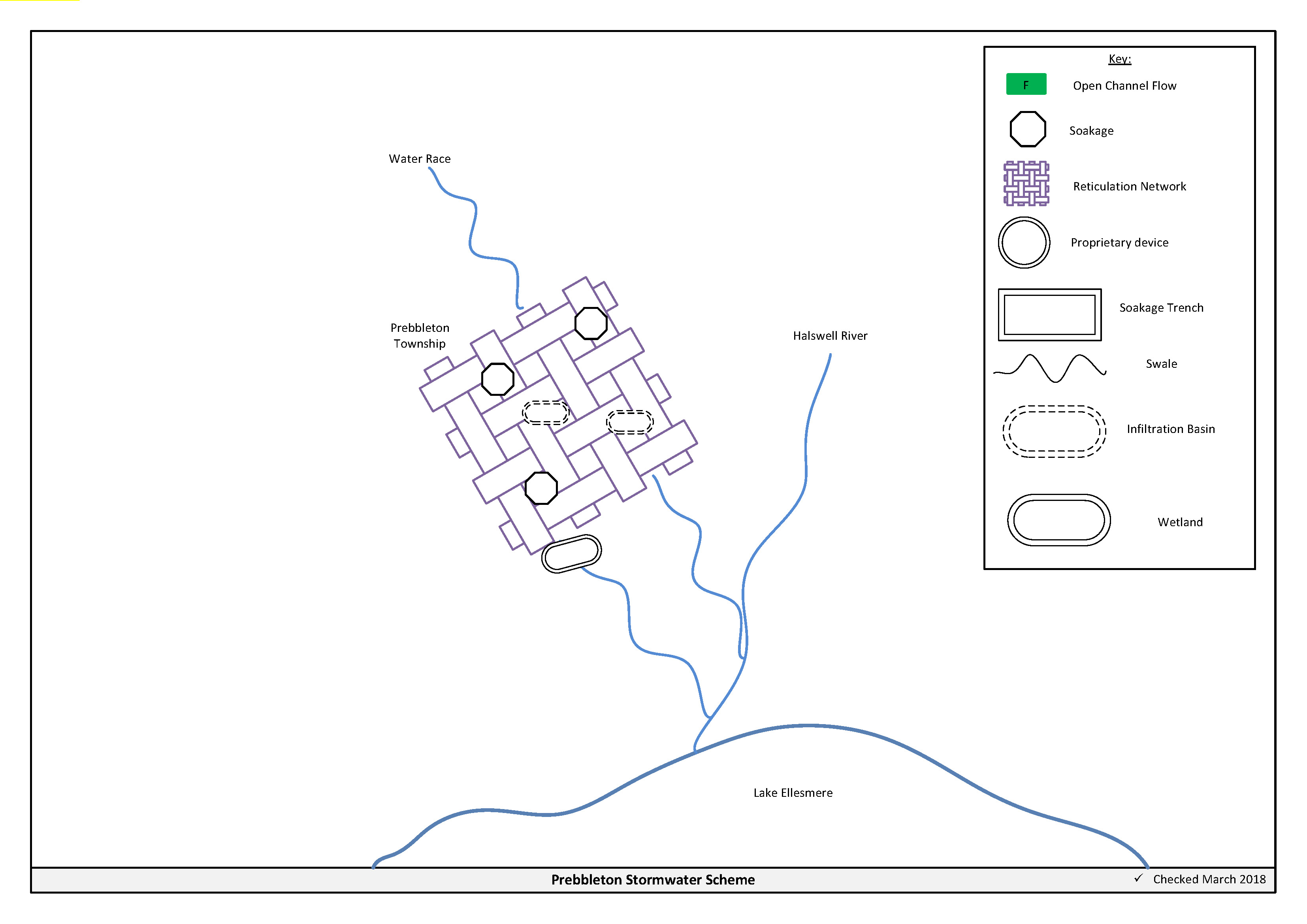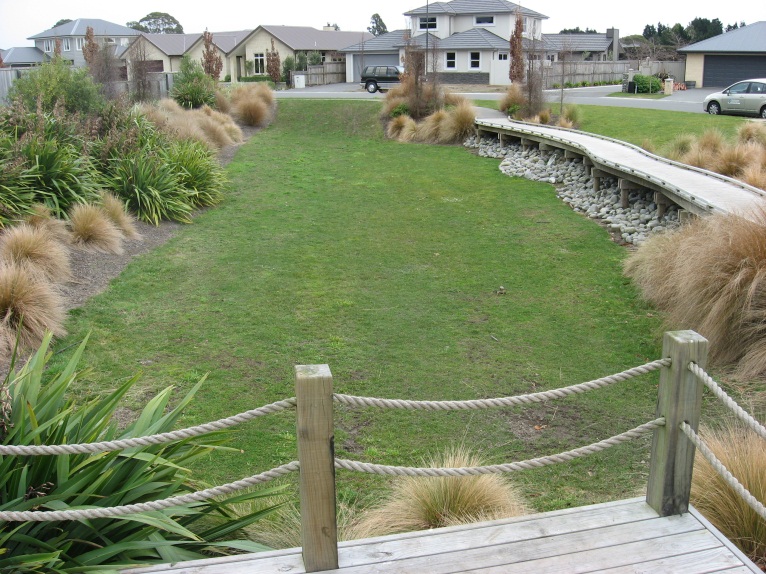<<
5-Waters-Volume-4-Stormwater
13 Prebbleton Stormwater Scheme
13.1 Scheme Summary
Scheme Area
| 248.57 ha |
| Scheme Coverage (as at 1 Jan 2021) | Rating numbers | 1,596
|
System components
| Piped (m) | 18,570
|
| Swales (m) | 7,546
|
| Drains (m) | 1,770
|
| Manholes/Inspection Chambers (No.) | 258
|
| Treatment | 12 infiltration basins / wetlands
11 rain gardens
|
| Other | 1 oil interceptor + 4 proprietary devices
138 soakholes
|
Value ($)
| Replacement Cost | $8,584,279
|
| Depreciated Replacement Cost | $7,905,742
|
| Financial | Operator cost (scheduled and reactive maintenance) per connection
| $46.13/connection
|
Planning
| Stormwater Management Plan | Draft
|
| No. SDC stormwater consents | 2
|
Demand
| Mean Annual Rainfall (mm) | 645 |
| 10% AEP (10 year) 1hr rainfall depth (mm) | 19.6 |
| Sustainability | Sustainable drain management practices | Adopted and Encouraged |
13.2 Key Issues
The following key issues are associated with the Prebbleton Stormwater Scheme. A list of district wide issues are located in 5Waters Activity Management Plan: Volume 1.
Table 13‑1 Prebbleton Scheme Issues
| Changing community expectations regarding presence of open drains in urban areas. | Plan for piping of key open drains. |
13.3 Overview & History
The Prebbleton catchment largely drains to ground or in the lower catchment in Dawsons creek and tributaries. The older parts of the network are predominantly piped with surface and ground discharges will little to no pre-treatment. Newer developments within Prebbleton typically include stormwater basins for treatment before disposal to ground or surface water.

Figure 13‑2 Scheme Schematic
13.4 Resource Consents
The Prebbleton stormwater scheme has a number of resource consents. Table 13‑2 shows the stormwater discharge permitted by the resource consents for this scheme.
Table 13‑2 Resource Consents
CRC070867.1
Issued - Active | To discharge contaminants into land | Trents Road, PREBBLETON | 3/09/2010 | 1/12/2041 |
CRC101788
Issued - Active | To discharge contaminants into land and water. | Corner Blakes and Springs Road, PREBBLETON | 15/02/2010 | 12/02/2045 |
CRC167469
Application in Process | To discharge stormwater from the existing stormwater network of Prebbleton | Prebbleton, Selwyn | | |
There are a number of other resource consents held by developers for this scheme.
13.5 Integrated Stormwater Management Plan
Environment Canterbury's Land and Water Regional Plan became operative on the 13th December 2018. Under policy 4.16, any reticulated stormwater system for an urban area requires a stormwater management plan. Additionally, from 1 January 2025, operators of reticulated stormwater systems will become responsible for the quality and quantity of all stormwater discharged from the reticulated stormwater system.
An Integrated Stormwater Management Plan has been lodged for Prebbleton (associated with consent CRC167469).
13.6 Scheme Assets
Council has a wide variety of stormwater assets within the district. A brief description of the assets within this scheme is provided below:
a. Oil Interceptor – Is a proprietary device which uses baffles to trap and contain hydrocarbons (oils and fuels).
b. Swale (Grassed) – Is a longitudinal open channel which is lined with grass. The swale both conveys and treats stormwater.
c. Reticulated network – Includes pipes, manholes, sumps. The primary purpose of the reticulated network is to collect and convey stormwater. Historically these systems were designed for the 2 year storm event. Today's engineering standards require the piped network to be designed for a 10 year event with overland flow provision for up to the 50 year event.
d. Infiltration basin – is a stormwater management device which is used to store, treat and dispose of stormwater to the ground via soakage.
e. Soakholes – Are used to dispose of stormwater to ground in areas where the ground water table is low and soil permeability is high.
f. Open drains – are channels used to convey stormwater. They are cost effective means to convey large volumes of water.
A summary of material and diameter for channels and pipes, where known, is shown below in Figure 13‑3 and Figure 13‑4.
Figure 13‑3 Pipe Material - Prebbleton
Figure 13‑4 Pipe Diameter – Prebbleton
13.7 Operational Management
The stormwater network is operated and maintained under two maintenance contracts as follows:
- Contract 1241: Water Services Contract. Contract is with SICON who undertakes investigations, conditions inspections, proactive and reactive maintenance and minor asset renewals.
- Contract 1202: Parks and Reserves Contract. Contract is with SICON who undertakes the maintenance of land scape features related to water services e.g. mowing, gardens etc.
Water quality sampling is completed under an agreement with Food and Health Ltd as required.
13.8 Photos of Main Assets
The photos below provide a summary of the types of assets found within this stormwater management area.

Photo 1: Typical Stormwater Infiltration Basin
|
13.9 Rapid Flood Modelling
The Council has undertaken 'Rapid Flood Hazard Assessment' modelling for its main townships. The modelling uses DHI MIKE 21 to simulate rainfall on grid with the outputs processed through ArcGIS producing maps illustrating a range of flood deeps during different rainfall intensities and durations.
The rapid flood assessment has been generated to provide a high level summary of potential flood and ponding areas across the district during extreme rainfall events. The results from this study are not to be used to set floor levels. The results have not been ground tested and therefore are indicative only.
For a 50 year event, Figure 13‑5 shows the predicted flooding for Prebbleton.

Figure 13‑5 Rapid Flood Modelling, Prebbleton
13.10 Risk Assessment
A risk assessment has been undertaken for the Prebbleton scheme. The key output from the risk assessment is the identification of any extreme and high risks which need to be mitigated. In order to mitigate these risks they have been included and budgeted for in the projects within this LTP. Table 13‑3 details the risk priority rating and Table 13‑4 outlines the risks.
Table 13‑3 Risk Priority Rating
| > 50 | Extreme | Awareness of the event to be reported to Council. Urgent action to eliminate / mitigate / manage the risk. Document risk and action in the AMP. |
| 35-50 | Very High | Risk to be eliminated / mitigated / managed through normal business planning processes with responsibility assigned. |
| 14-35 | High | Manage risk using routine procedures. |
| 3.5-14 | Moderate | Monitor the risk. |
| < 3.5 | Low | Awareness of the event to be reported to Council. Immediate action required to eliminate / mitigate / manage the risk. Document risk and action in the AMP. |
Table 13‑4 Risks - Prebbleton
| Non-consented activities | Renewal of consents | 2014 | 27 | 27 | 6 |
The list of district wide risks can be found in 5Waters Activity Management Plan: Volume 1.
13.11 Asset Valuation Details
The total replacement value of assets within the Prebbleton Scheme is $8,584,279 as detailed in Table 13‑5 below.
Table 13‑5 Replacement Value, Prebbleton
Stormwater Reticulation
| Chamber | $27,241
|
| Channel | $407,934
|
| Inlet-Outlet-Point | $168,723
|
| Lateral | $395,782
|
| Management Device | $274,345
|
| Manhole | $1,569,866
|
| Pipe | $5,677,474
|
| Soakhole | $57,933
|
13.12 Renewals
The renewal profile has been taken from the 2019 5 Waters Valuation. A graph showing the renewals for this scheme are shown by Figure 13‑6 below. The majority of assets requiring renewal are culverts/pipes which occur in the year 2037/38.
Figure 13‑6 Prebbleton Stormwater Renewal Profile
13.13 Critical Assets
The criticality model for Prebbleton has been updated for the 2021 AcMP. The methodology of the criticality model can be found in 5Waters Activity Management Plan: Volume 1 and it provides details of how the criticality has been calculated for the reticulation assets. Table 13‑6 and Figure 13‑7 below show the calculated criticality for all of the assets within this scheme that have a recorded known length.
Table 13‑6 Length of Assets per Criticality Level
5
| Low | 15,326
|
4
| Medium-Low | 1,809
|
3
| Medium | 3,256
|
2
| Medium-High | 2,076
|
1
| High | 96
|
13.14 Asset Condition
The asset condition model was run for Prebbleton in 2021. The methodology of the model can be found in 5Waters Activity Management Plan: Volume 1 and it provides details of how the model has been calculated for the reticulation assets (particularly pipes). Figure 13‑8 below shows the level of asset condition for all of the assets within this scheme that have a recorded known condition.
Table 13‑7 provides a description of the condition rating used within the condition model.
Table 13‑7 Asset Condition Grading
| 1.0 | Excellent |
| 2.0 | Good |
| 3.0 | Moderate |
| 4.0 | Poor |
| 5.0+ | Fail |
13.15 Funding Program
There are no projects specific to the Prebbleton scheme in the 10 year LTP budgets, however the scheme will benefit from a number of district-wide initiatives. Expenditure and renewals have been reported on a district-wide basis in Volume 1.
All figures are ($) not adjusted for CPI “inflation". They are calculated on historical data, and population growth where relevant.
An explanation of the categories within the budgets are as follows below:
-
Expenditure consists of operation and maintenance costs;
-
Renewals are replacement of assets which are nearing or exceeded their useful life;
-
Projects are investigations, decisions and planning activities which exclude capital works; and
-
Capital projects are activities involving physical works.
The list of district wide projects can be found in 5Waters Activity Management Plan: Volume 1.
Discussion on Projects
Projects have been determined based on their:
- Relevance to the scheme
- Requirement to be completed under legislation
- Ability to bring the scheme up to or maintain the Level of Service required under council's Asset Management Policy.
Many projects are jointly funded by more than one scheme and activity. Each scheme pays a pro-rata share only, equivalent to the number of connections.
Discussion on Capital and Projects
Where relevant, Capital (Levels of Service) and Capital (Growth) projects have been included in the scheme financial details.
Levels of Service Projects and growth splits have been provided to ensure the costs of population driven works are clear.
<< 5-Waters-Volume-4-Stormwater

